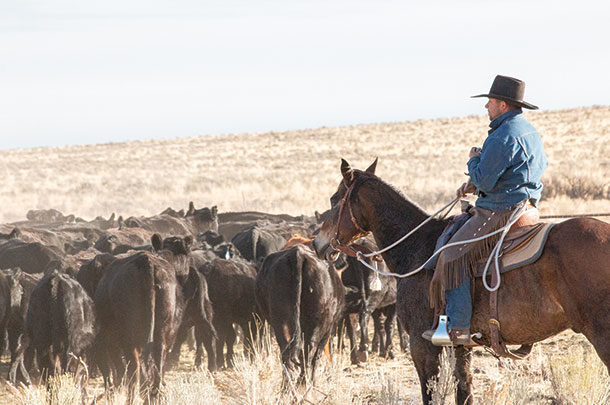The U.S. beef industry is poised to become an even larger provider of animal protein to the world’s growing population, but the question arises – how can it be successful when so many outside forces are striving to influence it? How does beef help feed the world, foster the environment, provide a living for those in the industry and protect a sustainable product consumers will accept and embrace?
Addressing the pillars
Dr. Myriah Johnson, senior director of beef sustainability research at the National Cattlemen’s Beef Association (NCBA), leads the sustainability research program aimed at identifying needs in the beef industry, administering grants and ensuring accurate research is done to direct and guide the program.
“When our research started, the industry had been hit hard from an environmental standpoint, so that’s where a lot of questions were. Naturally, that’s also where most of the sustainability research was done with environmental lifecycle assessments.”
Johnson says her department is working to transition more resources into the economic and social areas of sustainability.
“Hopefully, we can shift gears a little and expand the program, not decrease environmental sustainability research but grow the pie, so to speak, and layer in more economic and social research. The objective would be more balanced research over all three pillars of sustainability, working to make it holistic, as we know the segments are interrelated.”
She stresses the U.S. is the global leader in beef production, and on the environmental side, it claims the lowest emissions intensity in the world per unit over the past 25 years.
“Over 90 percent of beef animals are raised on family farms in the U.S., even though the media talks about corporate and big ag. People want to see cattle out on pasture being happy. Well, they spend the majority, over two-thirds, of their lives on pasture, no matter the production system.”
Tackling regulatory issues
The administration in power, combined with the happenings on Capitol Hill, shape the extent of available opportunities to tell their sustainability story, says Mary Thomas Hart with NCBA’s Environmental Council. As part of NCBA’s national resources team based out of their Washington, D.C. office, most of their work is focused on the EPA, regulatory issues, conservation portfolios, farm bills and implementation of voluntary conservation programs.
“With the beginning of the Biden administration, climate has become a larger focus. We’ve always talked about conservation; we can now also talk about our climate value, stressing all the good things cattle producers do. We’re constantly looking for the best ways to advocate our policy priorities.”
Hart says when they approach Capitol Hill and other administrative agencies, they continually try to ensure all three legs on the sustainability stool are studied. “Environmental sustainability isn’t and shouldn’t be considered in a vacuum. One of the best messages for and from cattlemen to the administration is [that] economic and environmental sustainability go hand in hand. Cattle operations provide green space, wildlife habitat and serve as natural water filters. But if ranches aren’t economically viable, we would lose all those environmental benefits.”
She explains the NCBA may be the only national cattlemen’s organization with environmental staff, plus they work closely with a broad range of other agricultural groups, sharing extended but related concerns.
“We try to bring the message to the administration about the positive things beef operations provide to the environment and economy, such as grassland sequestration potential, enhancement of wildlife habitat and reduction of wildfire fuel loads. Benefits we provide are tough to find in any other industry and we’re proud of that. The current focus on climate change has given us an incredible opportunity, and we’re trying to make the best of it.”
Gathering the data
To support this effort, a variety of market research is constantly being completed, says Shawn Darcy, senior director of market research and consumer insights of sustainability at NCBA. His department focuses approximately 90% on consumers and the other 10% on varied stakeholders.
They gather scanner data from grocery stores, transactional and volume data from food service, as well as foundational consumer survey information monitoring attitudes and usage on topics such as taste, convenience, price, production-related bias and nutritional ideas.
Beyond this, they work together with other internal NCBA groups – such as the nutrition, sustainability and consumer promotion teams – to evaluate content before it goes live.
“It’s like a risk management tool helping them be more efficient and better able to manage. We’re behind the scenes collecting and analyzing data. We look at what choices buyers are making, what is influencing those choices and why? We want to make sure we understand how beef resonates with customers, recognizing where we’re falling behind and how we’re doing against other proteins.”
He says messages are managed in social media, video posts or in response to news items to demonstrate the NCBA is focused on sustainability and making sure positive stories are reaching shoppers. Approximately 70% of gathered information is used by other teams to tell these stories.
“At a high level, people have a varied view of what sustainability is,” Darcy said. “Animal welfare is the top aspect they define it by, even above environment issues. Consumers are further away from their food than they’ve ever been and reinforcement on animal welfare is extremely important. This research is top of mind at the NCBA. We’re working hand in hand with our sustainability messaging, consumer promotion and reputation management teams to get this information out and see where the gaps in knowledge are.”
According to Johnson, there’s no silver bullet when it comes to sustainability and stewardship of the U.S. beef industry.
“It’s going to come from a wide spectrum of practices and from all sectors of the supply chain. The NCBA has made great strides in a multitude of areas including genetics, new technologies, animal health and across the spectrum in management. When shoppers consider beef, they should think about getting it from the ones who do it best regarding environment, production, efficiency, management and sustainability. That’s the U.S. beef producers.”










